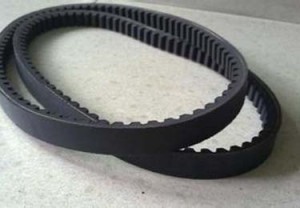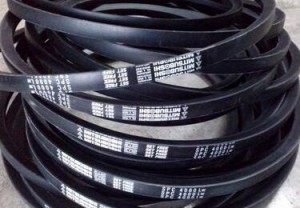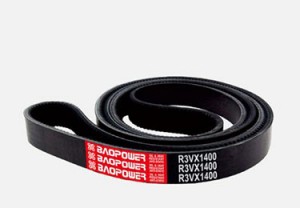Cogged banded V-belts are essentially two or more Cogged classic v belts that are connected together. They are used in instances when the pulley design of the machine requires two or more cogged V-belts joined together to connect multiple pulley drives in order to avoid load fluctuations or belt turnover. Cogged banded V-belts are banded across the back of the belt to keep them together. By connecting them together, you get a stronger application and consistent tensioning across all of the belts. It also makes the belt more rigid, which then increases friction, thus making it easier to apply to a machine.
The cogs run horizontally on the underside of the belt for better traction. Cogged V-belts work well with smaller-diameter sheaves and can withstand reverse bending, high linear speed and high-speed ratios. However, since the V-belt is cogged, there is a risk of the belt missing the cog and becoming misaligned. Other than the cogs, cogged V-belts operate like classic V-belts.
Classic V-belts are the most tried and true belts in the industry. V-belts help to solve the problem of alignment and slippage for power transmissions. They are now also the most commonly-used belts for power transmissions as well. The primary function of a classic V-belt is to disseminate power from a primary power source, such as a motor, to the secondary power unit. V-belts excel at providing the best combination of bearings, speed transfer, traction and belt-life longevity. The trapezoidal — or “V” — shape of the belt helps it to track in the similarly-shaped grooves of the machine so the belt does not slip off while in use. While the V-belt tracks in the grooves, the belt creates a deeper wedge to better handle the increasing loads, which then increases torque tension and power distribution. As friction increases, so does temperature.
V-belts are typically made out of rubber or a polymer, but may also have fibers from other materials added for reinforcement. Classic V-belts have a high resistance to temperature (-31 degrees F to 158 degrees F), but more of a limited resistance to oil.
V-belts were made originally to replace leather belts in industries such as heating, ventilation and air conditioning (HVAC), facility maintenance, material handling, oilfield supply, agriculture and rock crushers. Agriculture and industrial settings are the most common places to find classic V-belts being used. V-belts may also be referred to as light-duty (or “fractional horse power”) because they can only handle less than one horse power. These V-belts are designed with a 40-degree angle to “wedge” the belt into the groove of the pulley. There are also standard-duty V-belts, which can handle 1 horse power up to 500 horse power. The greater the load, the greater the wedging action. The manufacturing process combines a rubber compound with a polyester cord to increase strength and stability. Many classic V-belts are also available as Kevlar V-belts.
Classic V-belts generally are put into two different categories, based on construction: Envelope and raw edge.
Envelope: Also known as “wrapped” or “jacketed”; these V-belts have a fabric cover and a higher resistance to oil and high temperatures. When in a machine, they can be used as friction clutches upon start-up.
Raw edge: These do not have any type of cover, thus not as resistant to oil and high temperatures as wrapped V-belts. However, they are more efficient, generate less heat, increase power ratings, allow smaller pulley diameters, and ultimately, have a longer life.
In addition to the above categories based on construction, there are five main categories (A, B, C, D, E) of classic V-belts and they are categorized by their top width and internal length: A (1/2″ top width), B (21/32″ top width), C (7/8″ top width), D (1-1/4″ top width) and E (1-1/2″ top width).
ZHEJIANG POWERBELT CO. LTD. was established in 1994 by Mr. RenPing Bao, which locates in No. 27 of ShiFeng East Road, Tiantai City, Zhejiang Province, China. Now it’s one of the leading manufacturers specializing in producing all kinds of high quality Rubber Betts, induding Wrapped V Belt, Cogged V Belt, Timing Belt, Poly V Belt and Conveyor Belt.


